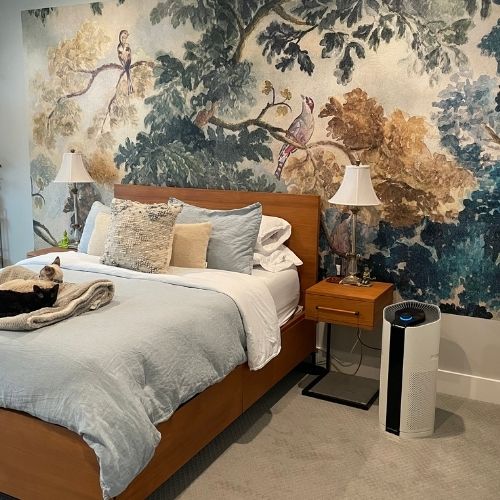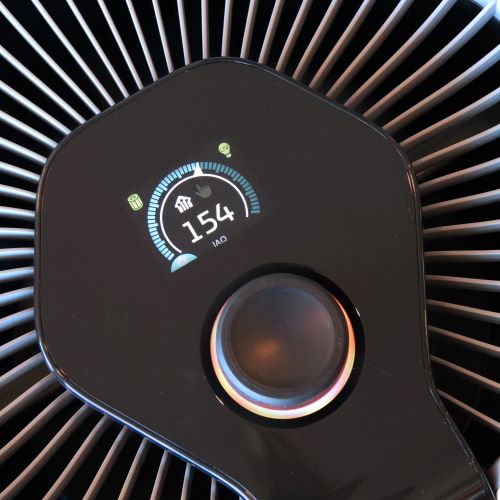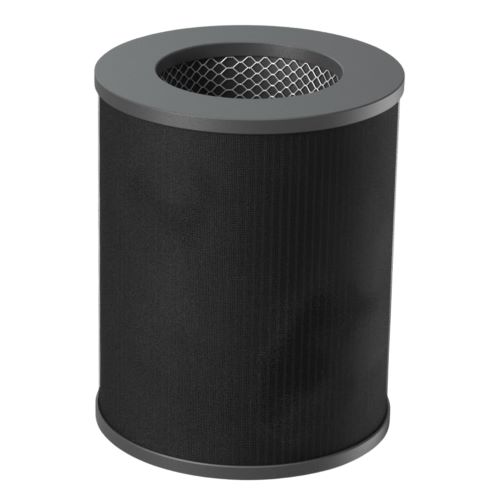Many people spend the vast majority of their time indoors, especially when the temperatures drop or when we gather together. Yet according to the Environmental Protection Agency (EPA), you are two to five times more likely to encounter pollutants inside compared to outside. This includes pollutants like mold, pet dandruff, tobacco, bacteria, viruses and many other toxins that may trigger allergies and other health problems. Many of these harmful particles and substances are too hard to get rid of with simple cleaning supplies. Whether it be because of their size or chemical nature, even bleach can struggle with fully sterilizing a room.
Fortunately, there is still
a solution. Air purifiers are able to improve air quality by removing
pollutants and ventilating the area with fresh
clean air. Depending on what you need, an air purifier can purify a single room
or your whole home with the right setup. Because air purifiers filter out unwanted particles, there are several great benefits that come with using an air purifier. The most important one is that air purifiers reduce the likelihood of getting sick, be it from infection from bacteria or from suffering an allergy attack. Many air purifiers also improve room
odor, making for a fresher smelling room. By recycling air, it helps a room from being stale, providing for an overall better breathing experience. Below we walk through the decision process with you
the area with fresh
clean air. Depending on what you need, an air purifier can purify a single room
or your whole home with the right setup. Because air purifiers filter out unwanted particles, there are several great benefits that come with using an air purifier. The most important one is that air purifiers reduce the likelihood of getting sick, be it from infection from bacteria or from suffering an allergy attack. Many air purifiers also improve room
odor, making for a fresher smelling room. By recycling air, it helps a room from being stale, providing for an overall better breathing experience. Below we walk through the decision process with you
- How do air purifiers work?
- What should you consider when searching for the best air purifier?
- What makes the best air purifier, better than others?
- What are some of the best air purifiers to consider?
- Do I need the best?
Our team of air purification experts here at Air Health are here to share everything you should know about air purifiers.
How Do Air Purifiers Work?
Air purifiers work similarly to other ventilation systems, but on a much finer scale. Generally speaking, inside your purifier is a fan that circulates air throughout a room. Inside the purifier is a filter, which acts as a net for harmful and toxic particles. The filter captures harmful particles, while the purifier pushes out the now cleaner air into the room. Although this may sound fairly simple, this does not tell the whole story about how air purifiers work to keep your air safe. Let's start by looking at filters. There are different types of filters that can be added to an air purifier.
How Do I Choose an Air Purifier?
There are many different air purifiers, each of which have different features, purposes, budgets, benefits, and more. When considering an air purifier, here are a few good questions you should ask yourself:
- What do I need to filter? Some air purifiers are made just for providing allergy relief from pets, pollen, mold, and more. Others are designed with a wider range of gasses and pollutants in mind, including smoke. The more particular you are about cleaner air, the more you should consider purifiers that combine multiple technologies to ensure the cleanest and freshest air.
- What size of room do I want to purify? How many rooms? Another major question is how many rooms you want to freshen up, along with the size of each room. Smaller budget purifiers cover small areas like a bathroom or car. Larger, but typically better purifiers, can cover a whole floor or even a whole house.
- How fast do I need the air to be cleaned? There is a measurement you should consider when purchasing an air purifier. The term CADR stands for Clean Air Delivery Rate. It is a measure of the effectiveness of an air purifier in removing specific pollutants from the air. The higher the CADR, the faster the air purifier will be able to clean the air in a given space. The CADR is determined by testing the purifier in a controlled environment, using specific pollutants such as tobacco smoke, dust, and pollen. The CADR rating is expressed in cubic feet per minute (CFM), and it reflects the volume of air that the purifier can clean of a specific pollutant within a set time period. CADR is an important factor to consider when buying an air purifier because it can help you determine how well the purifier will work in a particular space. If you have a large room with high levels of pollution, you will want to choose an air purifier with a high CADR to ensure that it can effectively clean the air. On the other hand, if you have a smaller room with lower levels of pollution, you may be able to get by with a purifier that has a lower CADR. Overall, CADR is an effective way to compare the performance of different air purifiers and to determine which one will be most effective in improving the air quality in a particular space.
- What features do I need? Along with size and shape, purifiers differ in their extra functionality. Here are a few of the extra benefits you can get from your air purifier.

- Display - Some air purifiers will include a display that shows aspects of the unit such as fan speed and air quality.
- Speed Control - Some air purifiers give the option to adjust the speed of the fan affecting how quickly the air is cleaned. While some will offer limited options, others will provide a range of speeds from 1 - 10 and maybe even a hidden 11th speed.
- Air Quality Sensors - Some units will include sensors that test the air and provide visual feedback on the quality of the air in your home or office. Many of us, because we can't see particles, are not sure whether we have a problem. This is a nice feature to give you peace of mind.
- Auto Mode - For the units that have air quality sensors, they may add an option to allow the unit to increase the fan speed automatically if the air quality decreases.
- App/WIFI Enabled - A WIFI enable air purifier will allow you the benefit of real-time updates along with the ability to control your unit with a smart-phone
- Smart Assistant-Enabled - Alexa and Google Assistants have become part of everyday life. Controlling your air purifier with only your voice is a nice upgrade.
- Do air purifiers have to be certified? Air purifiers may or may not need to be certified, depending on the specific regulations and standards that apply in the region where the purifier will be used. Here are a few to consider when looking at buying one:
- The Association of Home Appliance Manufacturers (AHAM) is a trade organization that represents the interests of the home appliance industry in the United States. AHAM certification is a process by which AHAM verifies the performance and specifications of home appliances, such as refrigerators, washing machines, and air conditioners. The certification process includes testing the appliance to ensure that it meets certain standards for energy efficiency, capacity, and performance. AHAM certification can be a useful indicator of the quality and performance of a home appliance.
- The Environmental Protection Agency (EPA) has established a voluntary certification program for air purifiers called the Voluntary Emissions Guideline (VEG) program. Participation in this program is voluntary, so not all air purifiers are required to be certified by the EPA.
- California has its own certification programs (California Air Resources Board - CARB) for air purifiers, which may be required for certain products sold or used in that state. It is important to check the specific regulations and standards that apply in your region to determine whether an air purifier needs to be certified.
- How much maintenance does my purifier need? Pay special attention to the recommended filter changes and maintenance recommendations when selecting an air purifier.
Now that we know what we are looking for, let's dig deeper into the technology to help you make your decision. Let's start with filtering.
Are There Different Kinds of Filters in Low-End vs High-End Air Purifiers?
There are different types of filters that you will find in air purifiers, which determines the how well the air purifier cleans the air. Filters that can be used in air purifiers, include:
- Standard Filters or what some companies like to call HEPA-like filters. These filters are designed to capture a wide range of particles, but are not designed to capture a large quantity of the smaller particles. Therefore, some people with allergies still have symptoms after buying a low-end purifier.

- HEPA (High-Efficiency Particulate Air) filters or what might also be described as True-HEPA filters are designed to remove fine particles from the air, such as dust, pet dander, and pollen. They are highly efficient and can remove 99.97% of particles that are 0.3 microns in size or larger. There are several types of HEPA filters that can be used in air purifiers, including:
- H-13 HEPA - Filters with an efficiency rating of H13 can capture at least 99.97% of airborne particles with a size of 0.3 micrometers or larger.
- H-14 HEPA - Filters with an efficiency rating of H14 can capture at least 99.995% of airborne particles with a size of 0.3 micrometers or larger. These filters are considered to be "absolute" HEPA filters because they are able to capture almost all particles in the air.
Typically, the higher the price point, the higher the filter level in the unit. A lot of the low-price purifiers will have a standard or HEPA-like filter. As the price goes up, HEPA is introduced.
Are There Other Air Cleaning Technologies You Can Find in the Best Air Purifiers?
The better or even best air purifiers take air cleaning to a new level by adding additional features like carbon filters, UVC lights and PCO technology. These technologies help remove odors, germs, viruses, bacteria, mold spores, VOCs and more. There is a lot more floating through the air than just dust and pollen. Let's dive into each feature.
- UV (ultraviolet) Light - This technology can be effective at purifying the air by reducing certain types of microorganisms, such as bacteria and viruses, by damaging their DNA. It is important to note that there are different types of UV lights which provide different level of virus and bacteria fighting ability and UV light should be used in conjunction with other methods of air purification, such as filters, to ensure the most effective and safe air purification.
- UVA is the longest wavelength and is not very effective at reducing microorganisms. It is often used in tanning beds and has limited germicidal properties.
- UVB has a shorter wavelength than UVA and is more effective at reducing microorganisms.
- UVC has the shortest wavelength and is the most effective at reducing microorganisms. It is often used in air purifiers and water treatment systems. Some studies have found that LED UV lights may be less effective at killing certain types of microorganisms compared to traditional UV lamps.
- Photocatalytic oxidation (PCO) - This technology uses a combination of UV light and a catalyst, such as titanium dioxide, to create a chemical reaction that breaks down and removes pollutants from the air. Photocatalytic oxidation can be used to treat a wide range of contaminants, including volatile organic compounds (VOCs), odors, and certain types of bacteria. It is often used in air purification systems and water treatment plants to improve air and water quality.
- Carbon Filtration - These filters are made of activated carbon and are effective at removing odors and gases. They work by adsorbing these substances onto the surface of the carbon.
What Is the Best Air Purifier That We Recommend?
Different people have different air purification needs, so there won’t be a single perfect solution for everyone. That said, we do think there is a great air purifier that everyone should at least consider for their home. When shopping for a new air purifier, we highly recommend the Skye Portable Air Purifier.
We recommend the SKYE air purifier because it features the best of technology and features available on the market including:
- Stellar UVC Germicidal Lamps: UVC lamps reduce the risk of infection from bacteria, viruses, mold, fungi, and more.
- Activated Carbon: Activated carbon filters capture particles many other filters fail to catch. It will remove gasses from your home and leave it smelling better than ever.
- Patented PRO-Cell Technology: Highly recommended for new or recently refurbished homes. PRO-Cell technology targets VOCs such as paint based and new carpet toxins along with other harmful gases that other air purifiers miss.
- Medical Grade H13 HEPA Filtration: Capture the most minute air particles with a HEPA filter designed to guard against 99.97% of air pollutants. Pollen and mold begone.
- Large Pollutant Filtration: Moved into an older home or one full of pet hair? Powerful air sucking and oversized filters will provide extra airborne allergy protection.
- Massive Home Coverage: A single SKYE air purifier can cover even the largest rooms, or multiple rooms joined together. Skye filters 1,600 sq. ft. every 30 minutes or 3,200 sq. ft. every hour of use.
- Low Noise and Energy: The SKYE filters your air at as low as 22 decibels, which is equivalent to your refrigerator. It uses little energy as well for efficient air filtration.
- Smart Device Compatibility: Smart programing will automatically adjust fan speed settings depending on air quality or control and monitor remotely from your phone or smart device.
With an easy set-up, low maintenance, great portability, and proven air filtration effectiveness, the SKYE 5 Stage Smart Air Purifier is our current top recommended air purifier for cleaning the air in your home.
Improve Your Home with best Air Purifier available with Air Health:
Have questions about air purifiers? Want to discuss which air purifiers, such as ones that install in your HVAC system, are best suited for your needs? Then contact our team at Air Health today. With over 95 years in the HVAC industry, we will do our best to find you the best air purifier that will improve your health and make it easier to breathe at home.
 US Dollars
US Dollars
